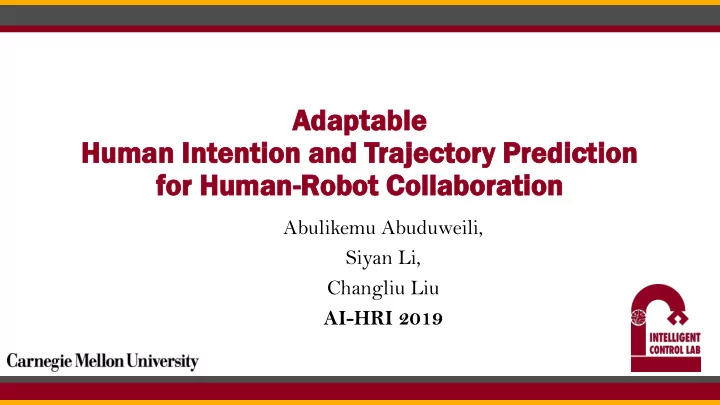

Ad Adap aptable able Hum uman an In Inten enti tion on an and Trajector ajectory y Pr Pred edict iction ion for for Huma uman-Robot obot Col olla laboration boration Abulikemu Abuduweili, Siyan Li, Changliu Liu AI-HRI 2019
Introduction INTENTION AND TRAJECTORY PREDICTION ● Usually separated, would like to combine ● Often require wearable devices (Pistohl et al. 2008, Wang et al. 2018) ● Computer-vision-based methods ONLINE ADAPTATION ● RLS-PAA to adapt the last linear layer of a fully connected network (Si, Wei, and Liu 2019) ● Adapting non-linear layers in more complex networks
1. . PIP PIPEL ELINE INE STR TRUCTUR UCTURE A general overview of our framework
Pro Proble lem m Sp Speci ecificatio fication • A task consisting of atomic individual actions • Must be able to be represented using an and-or graph • This step must be performed manually at this stage
Human Demonstration • Atomic actions must be repeated to the system • Gathering data for the neural network in the pipeline to learn features of the actions
Learning Trajectories and Intentions • Multi-task model Trajectory Prediction = Encoder- • Decoder Seq2Seq • Intention Prediction = Encoder- Decoder-Attention-Classifier • Input: x, y, z positions and velocities in x, y, z directions for the past N time steps • Output: trajectory and intention prediction for the next M time steps
Adapting to Real- world Tasks • Non-linear Recursive Least Square Parameter Adaptation Algorithm (NRLS-PAA) • Model updated every time ground-truth is received • Need to wait for the new ground truth
2. EXPERIMENTS Experiments we conducted to evaluate both the multi-task model and our adaptation
Collected Data • Collected from two Actors, A and B • Actor A performed each of the 12 actions 50 times (80% offline training, 20% offline validation) • Actor B performed each action 10 times (100% online testing)
Using Multiple Sets of Adaptation Steps • Implemented 1-step, 2-step, and 5-step adaptations • As adaptation steps increase, the time it takes to perform the adaptation increases as well
Using Multiple Sets of Adaptation Steps MSE (cm 2 ) Accuracy Without Adaptation 0.930 5.508 1-step Adaptation 0.938 4.919 2-step Adaptation 0.938 4.488 5-step Adaptation 0.946 3.964
Using Single-task and Multi-task Models • Single-task models for intention and trajectory predictions • Sharing encoder weights between single and multi-task models
Using Single-task and Multi-task Models MSE (cm 2 ) Accuracy Single-task Intention 0.899 - Prediction Single-task Trajectory - 5.909 Prediction Multitask Simultaneous 0.930 5.508 Prediction
Future Work
Prompts: • To which extent is the human intention and trajectory predictable? • How fast will the adaptation be considered fast enough?
Questions?
Referen erences ces • [Pistohl et al. 2008] Pistohl, T.; Ball, T.; Schulze-Bonhage, A.; Aertsen, A.; and Mehring, C. 2008. Prediction of arm movement trajectories from ecog- recordings in humans. Journal of neuroscience methods 167(1):105 – 114. • [Si, Wei, and Liu 2019] Si, W.; Wei, T.; and Liu, C. 2019. Agen: Adaptable generative prediction networks for autonomous driving. In IEEE Intelligent Vehicle Symposium, 2019. • [Wang et al. 2018] Wang, W.; Li, R.; Chen, Y.; and Jia, Y. 2018. Human intention prediction in human-robot collaborative tasks. In Companion of the 2018 ACM/IEEE International Conference on Human-Robot Interaction, HRI ’18, 279– 280. New York, NY, USA: ACM.
Recommend
More recommend